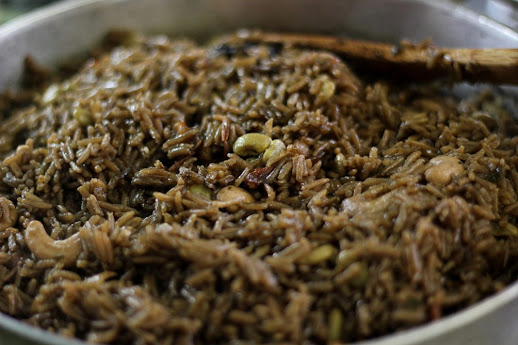Haitian Dish “Diri Djondjon” Gains Popularity With Non-Haitians
 |
| Diri ak Djon Djon, known in English as black rice, is an inevitable culinary fixture at Haitian holiday celebrations. Photo from Caribbean National Weekly. |
When Minna LaFortune was a young girl in Jamaica, her parents warned her about the small black mushrooms that grew wild around the island, saying the vegetable came from a netherworld of sorts. Years later, after she moved to New York, LaFortune learned otherwise.
“I was at a Haitian party when I was introduced to “diri ak djon djon” and noticed everyone was eating this,” said LaFortune, using the Creole phrase for rice with mushrooms. “I realized that if everyone was eating it, they were proving it to be edible.”
Diri djondjon, the shortened name for the dish in Creole also called “black rice” by English speakers, is a uniquely Haitian dish that is becoming more and more popular with non-Haitians as the culture spreads. Some experts believe the dish originated in northern Haiti and predates Haiti’s independence revolution from French rule. It spread throughout Haiti and, when the diaspora emigrated, became a staple on Haitian tables and holiday celebrations across the globe.
Now, the dish is turning up more and more in non-Haitian kitchens, restaurants and popular cooking shows worldwide. Diri djondjon also makes regular appearances on both Haitian and non-Haitian YouTube channels, personal Instagram accounts and various food blogs.
LaFortune is among those non-Haitians who has written about diri djondjon since having that first taste at the New York City Haitian party.
“Even though I’m not Haitian, I can tell you it’s divine,” said LaFortune, who resides in East Flatbush. “They add cashews, shrimp and lima beans to the rice and this makes it delicious.”
Creole cuisine creativity
Anthony Buccini, a food history specialist who has written an academic paper about diri djondjon, said its creation goes back to slavery on the island of Hispaniola. The slaves often foraged for food and explored the woods of the tropical land. That’s how they came upon the wild-growing vegetable.
The rice also has connections to cuisine from Africa, which the colonizers attempted to erase, Buccini said. Still, the slaves merged these ingredients to create the dish.
“Diri ak djon djon is a beautiful dish that is a symbol of a development of a new Creole cuisine,” said Buccini, who is Italian-American. “It was something they came up with from what they could find in the environment. They remembered the flavors of what they liked to eat, and once they had the chance to control their own diets, the African spirit [of] the cuisine came out.”
For those who grew up with djondjon, memories of the dish passing down through family remain significant.
“When my dad taught me how to make diri ak djondjon, he wasn’t teaching me how to make rice the way I would find in a cookbook,” said Michelange Quay, an independent Haitian-American filmmaker based in Paris. “The sharing of recipes like diri ak djondjon are actually revolutionary tools.”
Preparing authentic diri djondjon involves soaking the mushrooms overnight until the water turns black. That liquid is then used to cook the rice, giving it its distinct color and flavor, along with other Haitian spices. Original iterations called for dried shrimp, known as tri-tri, but various regional add-ins and preferences exist.
Across the diaspora, cashews and lima beans have become increasingly popular add-ins. So have using black Maggi seasoning tablets instead of soaking the mushroom overnight. Or, even sacrilegiously to some, using black rice from a bag.
“For djondjon to get passed [down] from generation to generation, it’s going to be adapted over time,” said Mireille Roc, a Brooklyn-based freelance chef who creates recipes for brands and cookbooks. “I’m sure the way I make it was not the way it was made 100 years ago.”
Roc, who has published her own diri djondjon recipes, said she prefers the original version, but the Maggi tablets are a cheaper and convenient alternative to the rare mushroom.
Covert cooking strategies
Djondjon is banned in the U.S., which Buccini, Roc, and LaFortune believe is because of the FDA’s particularly strong hesitation to allow produce from other countries.
As a result, preparing the dish is usually reserved for special occasions such as holiday celebrations and parties. With the exposure to larger groups in such settings, more non-Haitians have gotten to enjoy the dish.
“A majority of my non-Haitian friends want to know if we can make it and where I think is the best place they can get it,” said Jeanie Seide, an owner of a virtual office management company in Atlanta. “They always ask about diri ak djon djon.”
To keep a stash or supply the mushroom, some people resort to covert strategies.
“Some people are lucky and they know people who can actually sneak djondjon into their suitcase [from Haiti] and bring it here,” said Thecy Faustin, a resident of Irvington, N.J. “You have to package it really well so the smell will not get out of the suitcase.”
However it’s packaged or travels, one thing is clear: diri djondjon has crossover appeal.
This article was originally published in The Haitian Times.


Comments